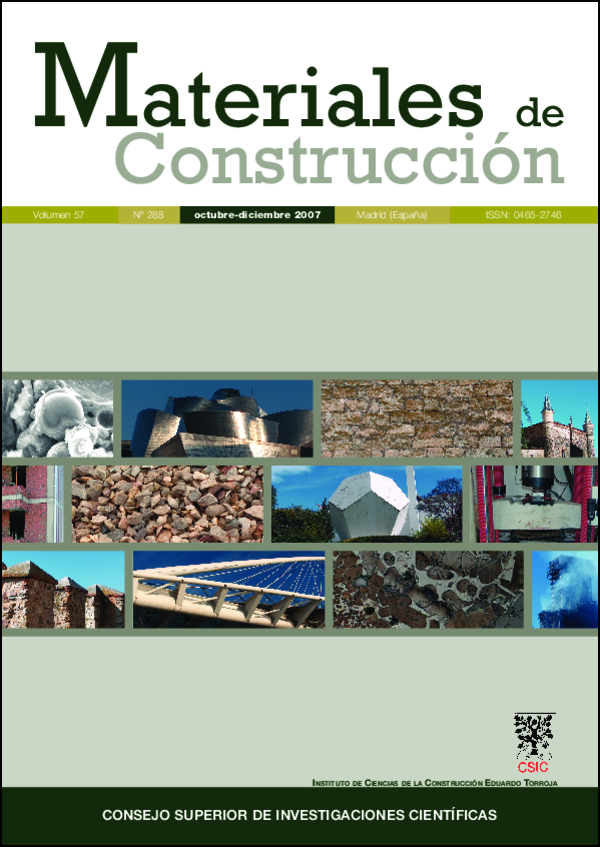Optimization of compressive strength in admixture-reinforced cement-based grouts
DOI:
https://doi.org/10.3989/mc.2007.v57.i288.67Keywords:
cement based grouts, bentonite, fly ash, silica fume, taguchi methodAbstract
The Taguchi method was used in this study to optimize the unconfined (7-, 14- and 28-day) compressive strength of cement-based grouts with bentonite, fly ash and silica fume admixtures. The experiments were designed using an L16 orthogonal array in which the three factors considered were bentonite (0%, 0.5%, 1.0% and 3%), fly ash (10%, 20%, 30% and 40%) and silica fume (0%, 5%, 10% and 20%) content. The experimental results, which were analyzed by ANOVA and the Taguchi method, showed that fly ash and silica fume content play a significant role in unconfined compressive strength. The optimum conditions were found to be: 0% bentonite, 10% fly ash, 20% silica fume and 28 days of curing time. The maximum unconfined compressive strength reached under the above optimum conditions was 17.1 MPa.
Downloads
References
(1) Huang, W. H.: “Properties of cement-fly ash grouth admıxed wıth bentonite, silica fume, or organic fiber”, Cem. Concr. Res., 27, 3 (1997), pp. 395-406. doi:10.1016/S0008-8846(97)00032-X
(2) Allan, M. L.: “Rheology of latex-modified grouts”, Cem. Concr. Res., 27, 12 (1997), pp. 1875-1884. doi:10.1016/S0008-8846(97)00205-6
(3) Tan, O. y Zaimoglu, A. S.: “Taguchi approach for investigation of the setting times on cement-based grouts”, Indıan Journal of Engineering and Materials Sciences, vol. 11 (2003), pp. 63-67.
(4) Tan, O.; Zaimoglu, A. S.; Hinislioglu, S. y Altun, S.: “Taguchi approach for optimization of the bleeding on cement-based grouts”, Tunnelling and Underground Space Technology, Volume 20, Issue 2 (2005), pp. 167-173.
(5) Zaimoglu, A. S.: “Bentonit ucucu kul ve silis dumani katkili cimento enjeksiyonu karisimlarinda fiziksel ve mekanik özelliklerin Taguchi metodu ile incelenmesi” (in Turkish), Ph.D. Thesis, Ataturk University, Erzurum (Turkey), 2003.
(6) ASTM standards: Standard test method for compressive strength of hydraulic cement mortars, Designation: C 109, (1998), pp. 71-75.
(7) Taguchi, G.: Tables for Orthogonal arrays and linear graphs, Maruzen, Tokyo, 1962.
(8) Ross, P. J.: Taguchi techniques for quality engineering, MC Graw-Hill, 1987.
(9) Roy, R. K.: A Primer on the Taguchi Method, Competitive Manufacturing Series, 1990.
(10) Huang, W. H.: “Improving the properties of cement-fly ash grout using fiber and superplasticizer”, Cem. Concr. Res., 31 (2001), pp. 1033-1041. doi:10.1016/S0008-8846(01)00527-0
(11) Mirza, J.; Mirza, M. S.; Roy, V. y Saleh, K.: “Basic rheological and mechanical properties of high-volume fly ash grouts”, Construction and Building Materials, 16 (2002), pp. 353-363. doi:10.1016/S0950-0618(02)00026-0
(12) Lane, R. O. y Best, J. F.: “Properties and use of fly ash in Portland cement concrete”, Concrete International, ACI (1982), pp. 81-92.
Downloads
Published
How to Cite
Issue
Section
License
Copyright (c) 2007 Consejo Superior de Investigaciones Científicas (CSIC)

This work is licensed under a Creative Commons Attribution 4.0 International License.
© CSIC. Manuscripts published in both the print and online versions of this journal are the property of the Consejo Superior de Investigaciones Científicas, and quoting this source is a requirement for any partial or full reproduction.
All contents of this electronic edition, except where otherwise noted, are distributed under a Creative Commons Attribution 4.0 International (CC BY 4.0) licence. You may read here the basic information and the legal text of the licence. The indication of the CC BY 4.0 licence must be expressly stated in this way when necessary.
Self-archiving in repositories, personal webpages or similar, of any version other than the final version of the work produced by the publisher, is not allowed.
















